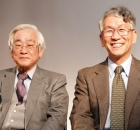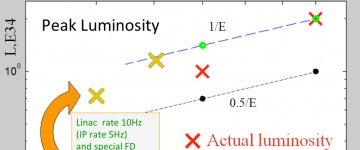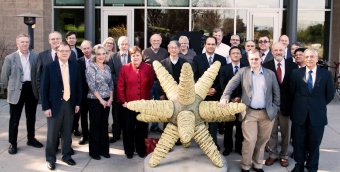The idea behind recycling is straightforward: reuse what you have to make more of the same.
Applying this concept, however, is seldom simple. In the case of Cornell University's Energy Recovery Linac (ERL), recycling energy to generate particle beams requires technological advancements that are born from decades of research. If scientists there fulfil their mission, they'll be able to use particle beams to accelerate particle beams, producing some of the brightest bunches to be made by an accelerator.
Image of the week
FALC meets at SLACSculpting the future: the members of the Funding Agencies for Large Colliders, or FALC, took a break from their discussions about the next-generation linear collider at SLAC last Saturday to gather around a work of art for a group picture. Read more about their meeting in SLAC Today. |
In the News
-
From CERN Courier25 January 2011The first results from the Planck mission, released on 11 January, are already providing new insights into astrophysics and augur well for the future, with plenty more contributions to cosmology still to come.
-
From businessworld.in22 January 2011‘Collider’ is an extremely readable science book taking you on a scintillating journey into the enigmatic world of particle physics and the contributions of the LHC, an engineering marvel
-
From New York Times21 January 2011… Physics is an international pursuit. Fermilab is home to physicists from all over the world, and other experiments will still take place there, as will work with the Large Hadron Collider. Yet it’s lamentable to see the end of an era of high-energy particle experiments in America that defined the threshold of our understanding of matter.
-
From The Beacon News21 January 2011BATAVIA — While the Tevatron will close, Fermi National Accelerator Laboratory still will have its place of importance in the world of physics research, Fermilab Director Pier Oddone said Wednesday.
Copyright © 2025 ILC International Development Team




